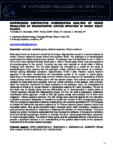Please use this identifier to cite or link to this item:
http://www.alice.cnptia.embrapa.br/alice/handle/doc/1032054| Title: | Suppression subtractive hybridization analysis of genes regulated by magnaporthe oryzae infection in wheat adult plants. |
| Authors: | TURCHETTO, C.  GONZÁLES, H. H. S.   TORRES, G. A. M.   NHANI, A.   CONSOLI, L.   BINNECK, E.   |
| Affiliation: | ANTONIO NHANI JUNIOR, CNPT; LUCIANO CONSOLI, CNPT; ELISEU BINNECK, CNPSO. |
| Date Issued: | 2015 |
| Citation: | In: CONGRESSO BRASILEIRO DE GENÉTICA, 61., 2015, Águas de Lindóia. Pós-genômica: [resumos]. |
| Pages: | p. 34. |
| Description: | Blast (also known as brusone), caused by the fungus Magnaporthe oryzae, is a serious disease of wheat (Triticum aestivum) across central and southern Brazil. The pathogen is a hemibiotrophic ascomycete that attacks several grass species. The disease was first described in rice in 1600 in China and it was reported infecting wheat ears in 1985 in Paraná state, Brazil, and since spread to all growing-regions in the country. Currently has been also reported on wheat fields in Bolivia, Paraguay and Argentina. The rice blast disease has emerged as a model for the study of phytopathogenic fungi showing that this pathogen initially colonizes host tissues as a biotroph, without causing detectable symptoms. Approximately 72?96 h after infection, lesions become apparent in the plant, characterizing the necrotrophic growth of M. oryzae. In wheat plants, depending on the developmental stage at which infection occurs blast can be devastating. Infected heads produce small and wrinkled grains with low specific weight. Few cultivars are described as resistant to wheat blast and fungicides have low control efficiency of the disease. Little is known about the molecular mechanism of wheat resistance to the pathogen. Here, we investigated the responses of wheat to M. oryzae infection in reproductive stage at 40 h after inoculation. The aim of this study was to identify genes that are differentially up- or downregulated in adults plants of Triticum aestivum infected with Magnaporthe oryzae. For this, we used a suppression subtractive hybridization (SSH) approach. A total of 420 high-quality contigs were isolated, 415 of them were mapped in Triticum aestivum genome. The 420 contigs were searched against the non-redundant nucleotide and protein databases in GenBank to predict the function for the corresponding genes. Fifty-five contigs corresponded to defense-related genes. We used the quantitative RT-PCR analysis to validate the differential expression patterns for 16 Triticum aestivum genes between control and inoculated spikes. Nine genes presented higher transcript levels under inoculation, including one gene previously described as responsive to Magnaporthe infection on wheat seedlings. This gene coding one protein membrane-associated that may increase the adhesion of the plasma membrane to the cell wall during pathogen infection. In contrast, the other 7 genes presented higher expression in mock-inoculated spikes. The study of these genes and the associated defense mechanisms can provide a significant advance in our understanding of the putative determinants of the resistance mechanisms of this wheat resistant genotype. |
| Thesagro: | Trigo |
| Type of Material: | Resumo em anais e proceedings |
| Access: | openAccess |
| Appears in Collections: | Resumo em anais de congresso (CNPSO)  |
Files in This Item:
| File | Description | Size | Format | |
|---|---|---|---|---|
| suppression.binneck.2015.pdf | 246.01 kB | Adobe PDF |  View/Open |









